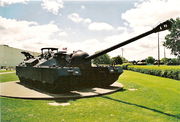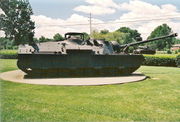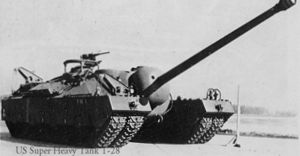T28 Super Heavy Tank
- For other uses, see T28 or T95 (disambiguation)
|
|||||||||||||||||||||||||||||||||||||||||||||||||||||||||||||||||||||||||||
The T28 super heavy tank (also called 105 mm Gun Motor Carriage T95) was a prototype heavily armored self-propelled gun designed for the US Army during World War II. It was originally designed to be used to break through German defenses at the Siegfried Line, and was later considered as a possible participant in an invasion of the Japanese mainland. Although sometimes referred to as a super-heavy tank the T28 was re-designated as the 105 mm Gun Motor Carriage T95 in 1945 and then renamed a super heavy tank in 1946.[3]
Contents |
History
The T28 was designed as a counter to the German heavy tanks,[2] such as the Maus[4] It was also set to be used for attacking the German Siegfried Line.[3]
It was first conceived in the spring of 1945, too late to be used in World War II. The original name for the project was to be T28. The Pacific Car and Foundry Company designed it for the final push in Europe, but by the time the first tank was completed and ready for combat, the war was over.[1] The original plans called for five prototype vehicles to be built, and eventually for a total of twenty-five tanks to be constructed.[3]
Renaming and cancellation
Because this vehicle did not have a turret, the T28 more closely resembled a self-propelled gun and was redesignated as the T95 Gun Motor Carriage in 1945, but in June 1946, the vehicle was, again, redesignated Super Heavy Tank T28.[3] It has been argued that it was neither a super-heavy tank nor a self-propelled gun, but that it was in fact a very heavy tank destroyer intended for German heavy tanks.[2]
Two prototypes of the T28 were built. They underwent evaluation at the Aberdeen Proving Grounds and the Fort Knox facilities until 1947. In 1947 one of the T28s was heavily damaged by an engine fire during trials at Yuma Proving Grounds and scrapped, and the other T28 was reported broken up and also sold for scrap. The T28 never went into service. This was because during the later stages of T28 development and evaluation were overtaken by that of the T29 and T30.[3] The T29 mounted the same gun in a conventional rotating turret. The T30 was developed with a larger-caliber gun and more powerful engine. Because of this the T28 program was terminated in October 1947.[3]
Surviving vehicle
In 1974 the last prototype was discovered abandoned in a back field at Fort Belvoir, Virginia. It is unknown where it spent the intervening 27 years. It is the sole remaining example of these tanks and was exhibited at the Patton Museum of Cavalry and Armor in Kentucky.[1][5] It is currently being prepared for shipment to its new home at Fort Benning, Georgia.
Design

The T28 was designed and manufactured by Pacific Car and Foundry.[3] The mechanical superstructure was taken from a T23.[2] The original plan was to build five prototype vehicles, with a production total of 25. Its total weight when fully equipped would have reached 95 short tons (86 tonnes).[1] To carry this weight, it used four tracks instead of two, each 12.9 inches (328 mm) wide.[3] The outer tracks could be detached for easier transport.[1] After removal they could be fixed together to make a unit that could be towed behind the tank. Due to its extreme weight and low engine power, the T28 had extremely limited obstacle-crossing ability and could not cross any of the portable bridges available at the time, and so was considered impractical in the field and not suitable for production.
Turret and armament

The T28 had no conventional turret, with a casemate style hull instead, giving it a comparatively low profile. Its main armament was a 105 mm T5E1 gun, in a ball-shaped gun mantlet set into the hull front.[1] Although it was technically a part of a gun mantlet it was really attached to the hull.[2] Due to this it was not a true tank at all, but a "Gun Motor Carriage".[2] The traverse was limited to 10° right and 11° left, and elevation from 19.5° to -5°. When traveling, the gun was locked at the maximum elevation.[3] It also had an M2 Browning .50-caliber machine gun mounted above the commander's hatch.[1] The main gun had a muzzle velocity of 3,700 feet per second (1,130 m/s), with a range of up to 12 miles (19 km).[1]
Armor and engine
The armor was very thick compared to other tanks of the time, up to 12 inches (300 mm) thick on the front. This was considered heavy enough to provide protection from the 8.8cm/L71 cannon used by German heavy tanks.[3] The lower hull front had 5.25 in (130 mm) of armor, and the sides 2.5 in (64 mm). The suspension system and lower hull were covered with 4-in (100 mm) thick steel skirts.[3] The engine was a gasoline-powered Ford GAF V-8, delivering 500 hp,[1] which gave the underpowered vehicle a top speed of about 8 mph (13 km/h) and greatly limited its obstacle-climbing capability.[3]
Comparisons
Already mentioned are comparable German tank projects of World War II, the Maus and E-100.
The British A39 Tortoise was another super-heavy assault gun which had a similar history—six of the 78-tonne giants were built at the end of World War II (following in the wake of the aborted 80-tonne TOG1 and TOG2).
Earlier large projects which were never put into service include the unbuilt British Flying Elephant of 1916, projected to weight about 100 tonnes, the 120-tonne German K-Wagen of 1917–18, and the 69-tonne French Char 2C of 1921.
Comparison to the alternatives
| Specifications | T28 | T29 | T30 |
|---|---|---|---|
| Weight | 86.2 metric tons | 64 metric tons | 65.8 metric tons |
| Crew | 4 men | 6 men | 6 men |
| Engine | Ford GAF V-8 / 500 hp (373 kW) | Ford GAC four cycle 60 degree V12 / 650 hp (485 kW) | Continental AV1790-3 / 704 hp (525 kW) |
| Speed | 13 kilometers per hour | 32 km/h | 26.5 km/h |
| Maximum armor thickness | 305 mm | 279 mm | 280 mm |
| Length | 11.10 meters | 11.57 m | 11.57 m |
| Width | 4.39 meters | 3.80 m | 3.80 m |
| Height | 2.84 meters | 3.20 m | 3.20 m |
| Armament | 105 mm T5E1 gun | 105 mm gun T5E2 | T7 155 mm gun |
| Secondary armament | .50 Caliber Machine Gun |
|
7.62 mm machine gun |
| Ammunition | 62 rounds | 63 rounds | 34 rounds |
Comparison with other countries' designs
| T28 | Maus | A39 Tortoise | |
|---|---|---|---|
| Weight | 86.2 metric tons | 200 metric tons | 79.2 metric tons |
| Crew | 4 men | 6 men | 7 men |
| Engine | Ford GAF V-8 / 500 hp (373 kW) | MB517 Diesel / 1,200 hp (895 kW) | Rolls-Royce Meteor V12 / 600 hp (447 kW) |
| Speed | 13 kilometers per hour | 13 km/h | 19 km/h |
| Armor | 305 mm | up to 460 mm | 178 - 228 mm |
| Length | 11.10 meters | 10.2 m | 10.0 m |
| Width | 4.39 meters | 3.71 m | 3.90 m |
| Height | 2.84 meters | 3.63 m | 3.00 m |
| Armament | 105 mm T5E1 gun | 128 mm 12.8 cm Kanone 44 | 96 mm Ordnance QF 32 pounder |
| Secondary armament | .50 caliber Machine Gun | co-axial 75 mm KwK 44 L/36.5 | 3 x 7.92 mm Besa machine guns |
| Ammunition | 62 rounds | 32 rounds | 60 rounds |
See also
- List of U.S. military vehicles by model number
- Tank classification
Notes
- ↑ 1.00 1.01 1.02 1.03 1.04 1.05 1.06 1.07 1.08 1.09 1.10 1.11 "United States - Heavy Tanks". http://mailer.fsu.edu/~akirk/tanks/UnitedStates/heavytanks/HeavyTanks.html. Retrieved 1 October 2008.
- ↑ 2.0 2.1 2.2 2.3 2.4 2.5 2.6 Foss, Christopher. The Encyclopedia of Tanks and Armoured Fighting Vehicles. Spellmount. p. 544. ISBN 1862271887. http://books.google.com/books?lr=&id=YQlUAAAAMAAJ&dq=T28+Tank+american&q=T28&pgis=1#search. Retrieved October 2008.
- ↑ 3.00 3.01 3.02 3.03 3.04 3.05 3.06 3.07 3.08 3.09 3.10 3.11 3.12 3.13 "Battle Tanks". http://www.battletanks.com/articles.htm. Retrieved 2 October 2008.
- ↑ Sawodny, Michael; Bracher, Kai (1989). Armored Military Vehicles: Maus and Other German Armored Projects. Schiffer Publishing Co.. p. 47. ISBN 0887401864. http://books.google.com/books?id=w3S2AAAACAAJ&dq=Maus+and+Other+German+Armored+Projects&client=firefox-a.
- ↑ Patton Museum List of Exhibits
References
External links
- http://www.peachmountain.com/5star/Tanks_Patton_Tanks_T28_tank.aspx
- http://www.youtube.com/watch?v=CAKeIbSMzSw film clip
- http://armorfortheages.com/Museum/T28/T28MainPage.htm
|
|||||||||||||||||||||||||||||
